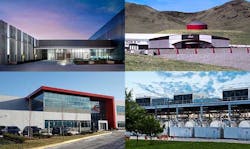Sorting out the largest data centers is a tricky task. In my 22 years of reporting on the data center industry, I’ve dug into this question several times (see The Top 10 Cloud Campuses from 2015 and The World’s Largest Data Centers at DCK in 2010). With the dynamic growth of cloud computing, these lists don’t age well, but provide an interesting snapshot of the history of building at scale.
Some of the largest cloud builders don’t disclose the size of their data center campuses, and much of the public data on campus size represents a mix of current and future capacity – and sometimes just future capacity.
But the trend toward larger campuses is undeniable, so we’ve sought to quantify the huge wave of MegaCampuses in the pipeline, as well as highlight some projects that don’t share many details about their scale. This task is best approached by viewing these projects in several groupings.
Largest Campuses With Public Data
Let’s start with campus projects that have published data about their development plans, including square footage of data center space.
- Compass Data Centers, Prince William County: In June, Compass Datacenters filed plans to build up to 10.5 million square feet of data center capacity in the Prince William Digital Gateway, a proposed 2,100-acre technology corridor in Manassas, Virginia which could accommodate up to 27 million square feet of data center development. Compass seeks to rezone 825 acres of land for its project. The Digital Gateway is controversial because it is adjacent to one of the Manassas Civil War battlefields and a state forest, but last week passed a key milestone when the Prince William Planning Commission recommended the project be approved by the Prince William Board of Supervisors, which is expected to review it next month.
- QTS Data Centers, Prince William County: QTS was the first company to reveal plans to expand at the Prince William Digital Gateway. Its rezoning application seeks to develop an 800-acre campus, with the ability to build about 7.9 million square feet of data center space. The capacity would be spread out, with QTS describing two areas of development: Digital Gateway North, with up to 5.3 million SF of development on 470 acres, and Digital Gateway South with up to 2.6 million square feet of space on 342 acres. The campus would be developed gradually, with full buildout expected by 2030.
- Digital Realty, Loudoun County: To secure its long-term expansion roadmap in Northern Virginia, Digital Realty plans to build one of the world’s largest multi-tenant data center campus on a 424-acre piece of land next to Dulles Airport, long known as the Western Lands. The Digital Dulles campus will create 7.5 million square feet of new data center space over a 15-year period, according to filings. The development plan features 11 super-sized data center buildings, ranging from 525,00 square feet to as much as 766,000 square feet.
- QTS Data Centers, Fayetteville, Ga.: Known as Project Excalibur, this QTS development is planned for 16 buildings and up to 7 million square feet, including 6.6 million SF of data centers and 400,000 SF of office space, according to filings with state agencies. QTS has purchased 615 acres of land in Fayetteville, which is about 20 miles south of Atlanta, and expects its buildout to begin in 2023 and continue through 2032.
- Switch, Reno: The Citadel Campus is planned to be the largest of the five massive CORE campuses developed by Switch. the Las Vegas-based digital infrastructure specialist. Switch has deployed more than 1 million SF and 130 megawatts at the campus, which was initially projected to reach 7.2 million square. Recent investor presentations say Switch plans to deploy an additional 5 million square feet of data centers, placing the campus buildout at about 6 million SF.
- Meta, Iowa: Altoona, Iowa will become Meta’s largest cloud campus with the addition of two new data centers, the company said in late 2021. The new capacity will boost Altoona to more than 5 million square feet of data center space, pushing it past the company’s Prineville, Oregon campus (4.6 million square feet). Facebook/Meta has multiple campuses that range between 2 and 4 million square feet.
- Switch, Las Vegas: The original Switch Supernap campus, now known as the CORE campus, has undergone continuous expansion since opening in 2008. It is Switch’s largest operating campus, with 2.34 million SF of data centers, and 315 MWs, and another 1.6 million square feet to come, placing the CORE campus just shy of 4 million SF.
- Yondr Northern Virginia: Yondr Group has acquired 270 acres of land in Northern Virginia, and plans to build 500 megawatts of data center capacity across Loudoun and Prince William counties. The exact campus sizes at these sites are not yet clear. The company’s principals have built more than 500 megawatts of data center capacity since 2011, including 9 million square feet Finland, the Netherlands and Belgium.
- AirTrunk Sydney 3: Australian hyperscale specialist AirTrunk has been building big for years, and recently announced its SYD3 campus in Sydney, a 320-megawatt project that the company says will be the largest on the Asia-Pacific region (excluding China). The project will give AirTrunk more than 450 megawatts in capacity in the greater Sydney region. While the company didn’t include square footage in its releases, the total megawatts place it among the top campuses.
Contenders of Unknown Dimensions
Lots of data center providers don’t disclose the square footage or power usage of their campuses. Some of these are clearly contenders for the title of world’s largest campuses – or will be soon.
- Google, Iowa: Google data center executive Joe Kava has described the company’s Council Bluffs, Iowa campus as the world’s largest data center campus. With the completion of its latest phase in February, Google has now invested $5 billion in its Iowa campus. Google kicked off the Iowa data center boom with its 2007 facility in Council Bluffs, part of the first wave of Google’s global deployment of massive data center campuses. It has expanded the campus gradually over the last 15 years.
- Microsoft, Southern Virginia: Microsoft’s campus in Boydton, Virginia is likely the largest of its many campuses around the globe. The campus has grown steadily across several generations of data center designs, including both containerized data center modules and traditional designs. The most recent disclosures place the project at 1.1 million SF, but satellite photos suggest the project has grown beyond that size. In 2021 Microsoft purchased 900 acres of land to further expand its operations in Mecklenburg County.
- Amazon Web Services, Ashburn: The digital infrastructure supporting the AWS cloud is massive, including about 50 data centers in Northern Virginia. Amazon’s infrastructure is distributed in clusters that typically include three data centers, which are spread across multiple smaller sites rather than a single huge campus, so Amazon doesn’t rank as high as it otherwise might in a ranking of campus size. This approach is driven by Amazon’s use of Availability Zones, which allow customers to run instances in several locations to avoid a single point of failure. While not a traditional campus, AWS has well over 1 million SF of data centers on contiguous properties in Ashburn, Virginia.
- Quantum Loophole, Maryland: The first Quantum Loophole campus in Frederick County won’t come online until early 2024, but is expected to arrive with 2,000 acres of land, 1,080 megawatts of power, and infrastructure to support energy strategies integrating natural gas, energy storage, and hydrogen. Quantum Loophole has already signed Aligned as its first tenant, and is positioned to create a new geographic sub-market to support the massive cloud cluster in Northern Virginia, which is experiencing power constraints in Ashburn.
What About China?
Over the years, we’ve seen many reports of massive, multi-million square foot campuses in China. Some of these reports appear to have overstated the size of the physical infrastructure, as noted recently by DataCenterDynamics, which struggled to document claims of several campuses. In the interest of sharing verifiable data, we looked at the public companies with investor reporting requirements first.
- ChinData: ChinData serves large hyperscale providers in China. The latest investor presentation from ChinData states that the company has 776 megawatts of capacity, which is hyperscale by any measure. The largest ChinData campus appears to be in Datong in Shanxi province west of Beijing, where the company says it has deployed 257 MWs of capacity, with plans for the campus to reach 500 MWs at completion. A 2020 story from ChinaDaily says the initial ChinData facility in Datong was 50 MWs, described as “Asia’s highest levels for a single data center.”
- GDS Data Centers: This publicly-held data center developer reports a total footprint of 5.42 million square feet across its portfolio, with its largest concentration in Beijing, where it operates 229,000 square meters of data center space, or about 2.46 million square feet.
- China Telecom: As DCD has noted, reports of the actual size of the company’s facilities are hard to verify. But media reports place the China Telecom Inner Mongolia Information Park in Hohhot at 10.7 million square feet.
- China Mobile: Several reports state that China Mobile operates a 7 million square foot data center in the Inner Mongolia Data Park, apparently neighbors with the largest China Telecom site.
EDITOR’S NOTE: This is not a ranking, as campuses from any of the three groupings could be the largest, and with more complete information, companies from all three groupings would likely populate any “top 10” list.
Have we missed any? Please share in the comments.






